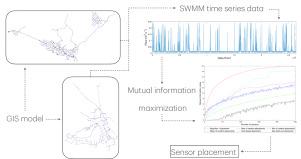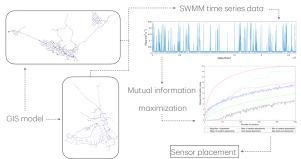大型下水道网络的信息论传感器布置
IF 11.4
1区 环境科学与生态学
Q1 ENGINEERING, ENVIRONMENTAL
引用次数: 0
摘要
公用事业运营商在管理污水网络时面临着一项具有挑战性的任务,即主动加强网络监控。为了解决这个问题,本文开发了一个优化下水道网络传感器布置的框架,目的是最大限度地获取有关网络状态的信息。为此,本文提出用互信息来衡量放置的传感器所获取的有关网络状态的证据。问题的提出利用了对网络状态的随机描述来分析系统中的互信息特征,并提出了传感器放置问题。为了规避安置配置中出现的组合问题,我们提出了一种新算法,即一步修正贪婪算法,该算法对所有可能的初始传感器安置采用贪婪启发式。该算法能在可计算时间内进一步探索初始贪婪解之外的其他解。该算法应用于两个真实的下水道网络,第一个是英格兰南部的下水道网络,包含 479 个节点和 567 个链接;第二个是丹麦贝林格村的下水道网络,包含 1020 个节点和 1015 个链接。通过使用线性模型和神经网络模型,将修改后的贪婪算法在估计未监控位置方面的性能与其他启发式放置方法进行比较,从而验证了修改后的贪婪算法的传感器放置方法。结果表明,在大多数情况下,一步式修正贪婪算法的传感器安置效果优于其他算法,并倾向于对传感器进行集群,以有效监控网络的部分区域。所提出的框架和改进的贪婪算法为污水处理运营商提供了一种传感器安置方法,使他们能够为大型网络设计数据采集和监控基础设施。本文章由计算机程序翻译,如有差异,请以英文原文为准。


Information-theoretic sensor placement for large sewer networks
Utility operators face a challenging task in managing sewer networks to proactively enhance network monitoring. To address this issue, this paper develops a framework for optimized placing of sensors in sewer networks with the aim of maximizing the information obtained about the state of the network. To that end, mutual information is proposed as a measure of the evidence acquired about the state of the network by the placed sensors. The problem formulation leverages a stochastic description of the network states to analytically characterize the mutual information in the system and pose the sensor placement problem. To circumvent the combinatorial problem that arises in the placement configurations, we propose a new algorithm coined the one-step modified greedy algorithm, which employs the greedy heuristic for all possible initial sensor placements. This algorithm enables further exploration of solutions outside the initial greedy solution within a computationally tractable time. The algorithm is applied to two real sewer networks, the first is a sewer network in the south of England with 479 nodes and 567 links, and the second is the sewer network in Bellinge, a village in Denmark that contains 1020 nodes and 1015 links. Sensor placements from the modified greedy algorithm are validated by comparing their performance in estimating unmonitored locations against other heuristic placements using linear and neural network models. Results show the one-step modified greedy placements outperform others in most cases and tend to cluster sensors for efficiently monitoring parts of the network. The proposed framework and modified greedy algorithm provide wastewater utility operators with a sensor placement method that enables them, for the first time, to design the data acquisition and monitoring infrastructure for large sewer networks.
求助全文
通过发布文献求助,成功后即可免费获取论文全文。
去求助
来源期刊

Water Research
环境科学-工程:环境
CiteScore
20.80
自引率
9.40%
发文量
1307
审稿时长
38 days
期刊介绍:
Water Research, along with its open access companion journal Water Research X, serves as a platform for publishing original research papers covering various aspects of the science and technology related to the anthropogenic water cycle, water quality, and its management worldwide. The audience targeted by the journal comprises biologists, chemical engineers, chemists, civil engineers, environmental engineers, limnologists, and microbiologists. The scope of the journal include:
•Treatment processes for water and wastewaters (municipal, agricultural, industrial, and on-site treatment), including resource recovery and residuals management;
•Urban hydrology including sewer systems, stormwater management, and green infrastructure;
•Drinking water treatment and distribution;
•Potable and non-potable water reuse;
•Sanitation, public health, and risk assessment;
•Anaerobic digestion, solid and hazardous waste management, including source characterization and the effects and control of leachates and gaseous emissions;
•Contaminants (chemical, microbial, anthropogenic particles such as nanoparticles or microplastics) and related water quality sensing, monitoring, fate, and assessment;
•Anthropogenic impacts on inland, tidal, coastal and urban waters, focusing on surface and ground waters, and point and non-point sources of pollution;
•Environmental restoration, linked to surface water, groundwater and groundwater remediation;
•Analysis of the interfaces between sediments and water, and between water and atmosphere, focusing specifically on anthropogenic impacts;
•Mathematical modelling, systems analysis, machine learning, and beneficial use of big data related to the anthropogenic water cycle;
•Socio-economic, policy, and regulations studies.
 求助内容:
求助内容: 应助结果提醒方式:
应助结果提醒方式:


